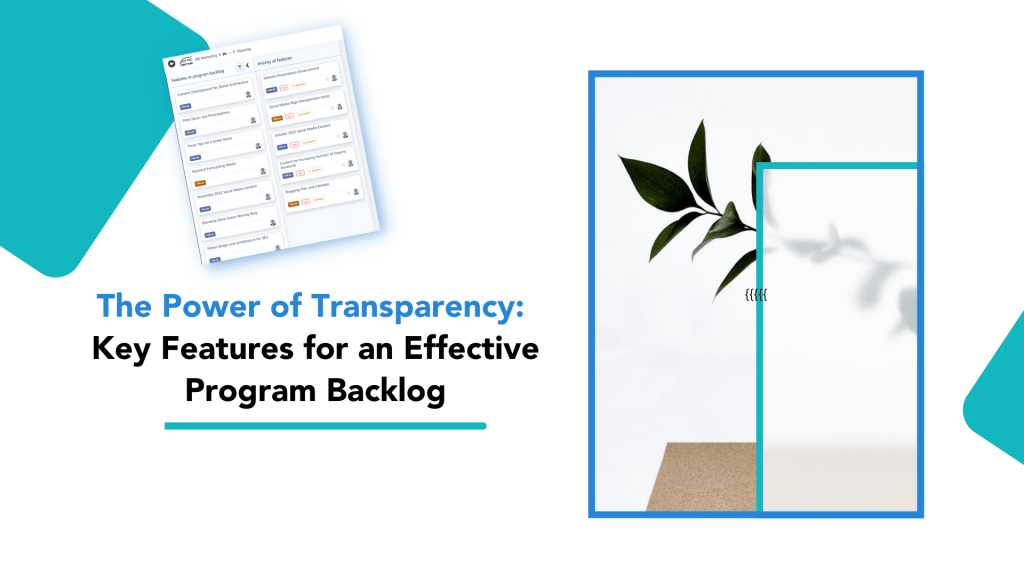Introduction:
Agile methodology has become increasingly popular in recent years, with many teams adopting it for project management. Agile methodology is focused on iterative and incremental development, where teams work in short sprints to deliver small and frequent updates. This approach allows teams to respond quickly to changes and deliver projects more efficiently.
However, managing an agile project requires the use of specific tools and techniques to ensure that the project progresses smoothly. In this blog post, we will discuss five agile tools that can help teams manage their projects effectively.
Agile Tool # 1: Kanban Boards
Kanban boards are a visual way of organizing tasks and tracking progress. They allow teams to visualize their workflow, identify bottlenecks, and optimize their processes. Kanban boards typically consist of columns that represent stages in the workflow, with each column containing cards that represent individual tasks. As a task progresses through the workflow, it moves from one column to the next.
For example, let’s say that a software development team is working on a new feature. The feature might start in the “backlog” column, then move to “planned” when it is scheduled for development, “in progress” when work begins, “testing” when testing is underway, and finally “done” when it is complete. The team can see at a glance where each feature is in the workflow, how long it has been in progress, and what needs to be done next.
Prakya uses visual kanban board management at the team, program, and portfolio epic levels to manage workflow and progress. Typically, Prakya’s teams use the Team Room Kanban to plan and execute work during the current sprint.
The progress at the team level is automatically propagated to higher levels, and features and epics move automatically along the kanban lanes. This saves teams time and ensures that progress is tracked accurately.
Agile Tool # 2: Burndown Charts
Burndown charts are a graphical representation of work remaining versus time. They help teams track progress, identify areas for improvement, and make informed decisions. Burndown charts typically show a horizontal axis representing time and a vertical axis representing work remaining. As work is completed, the line on the chart moves downward toward zero.
For example, let’s say that a development team is working on a two-week sprint to deliver a new feature. The team can use a burndown chart to track progress over the course of the sprint. The chart shows how much work remains to be done and how quickly the team is progressing. If the line on the chart is sloping downward at a slower rate than expected, it may indicate that the team is falling behind and needs to adjust their approach.
Prakya uses sprint metrics to draw various charts and reports to help program managers understand team progress and make informed decisions. These charts reflect real time information. Since Prakya is a cloud based SaaS platform, this information can be accessed anywhere and anytime.
Using Prakya’s burndown chart, program managers can track how the work is being executed. Along with that we can also see the capacity of the team and if the work is below, above or at capacity of the team! By looking at these metrics, program managers can take decisions in real time that allow teams to be productive without over-burdening them
Agile Tool #3: Retrospective Meetings
Retrospective meetings are a way for teams to reflect on their work and identify areas for improvement. These meetings are typically held at the end of a sprint or project and allow team members to share feedback, discuss what went well and what didn’t, and make suggestions for improvement.
For example, let’s say that a development team has just completed a sprint. The team can hold a retrospective meeting to reflect on their work. They might discuss what went well, such as completing tasks ahead of schedule, and what didn’t go so well, such as unexpected technical difficulties. They can then make suggestions for improvement, such as allocating more time for testing or improving communication between team members.
Prakya’s Footprints capability is also extremely helpful during retrospective meetings. Footprints is a log of every single action taken by the team, so the team can easily see what they did and when they did it. This capability can help teams identify any bottlenecks or inefficiencies in their process and work together to improve it.
Agile Tool #4: Feature Prioritization
Agile prioritization tools allow teams to prioritize their work based on business value and impact. These tools help teams make informed decisions about what work to focus on, allowing them to deliver the most value to their customers.
Let’s say a team is working on a mobile app for a client and they have a list of features and functionality that they want to include in the app. First, the team would create a list of all the features and functionality that they want to include in the app. They would then prioritize these tasks based on their importance and urgency.
For example, the team may prioritize the login and user authentication functionality as a high-priority task since it’s a core feature of the app that needs to be in place before anything else can be built.
Prakya offers an Agile prioritization tool that allows teams to prioritize features based on business value and impact. Teams can decide which features are important and visually arrange them in a hierarchy. The program manager can then lock the order of priority.
When teams access their work backlog in the team room, the user stories are organized based on this priority, allowing teams to understand which user stories need to be completed now and which user stories can be completed later.
This allows teams to focus on the most valuable functionality and complete it at the earliest so that customers get what they want when they want it.
Agile Tool #5 : Documentation Tools
Agile documentation tools help teams create and manage documentation for their projects. These tools enable teams to document business requirements, functional requirements, corporate strategy, project plans and solution architecture diagrams, ensuring everyone is on the same page and has access to the information they need.
Prakya offers a document store that allows teams to create and manage documentation for their projects. This documentation can be attached to a user story or a feature or a portfolio epic. The team can have access to these documents based on access rights given to them.
Documents can be created natively or you can store links from an external source like google drive. By using this capability, Prakya becomes a single source of truth for your teams. This capability alone allows your teams to save as much as 5 hours per week per person as teams don’t have to spend time searching for information spread over multiple tools.
Conclusion
In conclusion, using agile tools for project management is essential for effective and efficient development. Kanban boards, burndown charts, retrospective meetings, continuous integration and delivery, prioritization tools, and documentation tools are all important for agile teams.
Prakya is a cloud-based SaaS platform that offers a comprehensive set of capabilities for agile teams, including visual kanban board management, sprint metrics, program management, Footprints for tracking progress, and auto-suggestions for scaling work. By using these tools and techniques, agile teams can work together more effectively and deliver high-quality software products to their customers.





